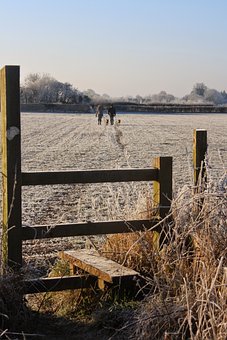10 February 2022
Country Style
Stiles: good or bad?
By Lynda Goetz

It is now two years since my partner’s beloved deerhound died. He was just over nine years-old, which is about the average lifespan for these large dogs. He was a very handsome beast with a lovely gentle temperament that is characteristic of the breed. He was, on the whole, very patient and tolerant of those many dogs, particularly terriers, who took offence at his size (see Shaw Sheet article on Dog Aggression). His size however was a drawback; not simply because it scared other dogs; nor because he took up more room on the sofa than the Labrador/Patterdale crossbreeds (Pattadors?) which we also own, he didn’t, (he always curled up very tightly, as if apologising for his size, whereas they luxuriate and stretch out); nor because he required a lot more exercise than they did, he didn’t; or even because he required larger portions of food, which he did. No, the problem with his stature (apart from the shorter life span) was that it precluded taking him on a number of local walks – because of the stiles.
A dog which stands around three feet high at the shoulder and is of a slim build with lanky legs cannot easily or even at all scramble over most country stiles. Nor can they slip underneath them. Indeed, unless there is an adjoining lift-up dog gate or you are prepared (as my partner was) to hoist the dog onto your shoulders before climbing over the stile, its size presents a complete obstacle to continuation of the walk. This is true even of some of the bulkier and less agile Labradors or other similar-sized dogs, not to mention people who fall into a similar category. I have no wish to be ageist or ‘fatist’ here, but there is little doubt that for some clambering over a stile after hiking across a muddy field (with at least a proportion of that mud adhering to the treads in their wellies or hiking boots) is not the easiest exercise. If, as recent statistics have suggested, over 63% of all adults in the UK are overweight (almost one in three), then the new guidance by Natural England that farmers should make their land more accessible to ‘visitors with different abilities and needs’ by replacing stiles with gates or gaps is perhaps helpful. Or maybe not?
Because of the problems we encountered, I did write to the local highways authority several years ago to ask if it would be at all possible to replace stiles with gates when they came up for repair/replacement. At the time, I think, I did not even receive a reply to my email, although on the government website where the obligations of the landowner are set out, it clearly states, ‘Where a stile needs replacing, always consider with the highway authority whether to do this with a gate or preferably a gap, so that it will be less of an impediment to people with mobility problems’. Perhaps they objected to my concern for the dogs, which I probably mentioned before the humans?
Interestingly, this ‘guidance’ has been in place since September 2014 (revised December 2015), but the latest Countryside Code from Natural England is specifically aimed, in two separate documents, at visitors to the countryside and land managers. Although there is little that is really new in the guidance, it is perhaps the emphasis which has changed. With the increased visitor numbers to the countryside resulting from the pandemic, those visitors need to be reminded of their obligations and responsibilities and landowners and managers perhaps nudged towards making that countryside more accessible to all. Walkers are reminded about control of their dogs, as well as the need to pick up their poo, as this can cause disease in farm animals. (This week also heralded the publication in The New Scientist of research done at Ghent University in Belgium by Dr Pieter De Frenne showing that dog faeces and urine increase the nitrogen and phosphorous in suburban nature reserves which can affect the biodiversity). They are also reminded to respect the land over which they are walking, to stick to footpaths and to close all gates to ensure livestock cannot escape.
It is this latter problem which makes farmers and landowners wary of demands for gates and gaps rather than stiles. As a spokesman for the NFU pointed out, farmers are also responsible for their livestock. Animals escaping can cause serious problems. Another issue as far as farmers are concerned is the cost of any replacement of existing structures. According to the 2014 guidance, they are entitled to claim ‘25% or sometimes more of the cost of any replacement work from the highway authority. Some authorities provide materials, or others may carry out the work themselves’. Sam Durham, the NFU’s chief land management agent said, “We’d be quite keen for new government schemes under agricultural policy to include elements that it’s not all coming out of the farmer’s pocket.”
Apart from the question of ‘who pays?’, there is the problem of style. As The Telegraph editorial points out, up in the Lake District (and indeed in Cornwall, and other places), stiles over dry stone walls often take the form of a flight of cantilevered flat stones or stout ladders. Putting gates in these walls is not in keeping with traditional style. Moreover, given the incline of some of these areas and the general nature of the terrain, is it really likely that mothers with pushchairs or wheelchair users are actually going to use them? The Telegraph mockingly suggests that, ‘Natural England aspires to a landscape criss-crossed with level paths like asphalt promenades in a municipal park. Then mobility scooters will sally from car parks to survey country that’s no longer there’. Large dogs on the other hand might acquire a freedom to roam amongst livestock which farmers are very keen to avoid.


